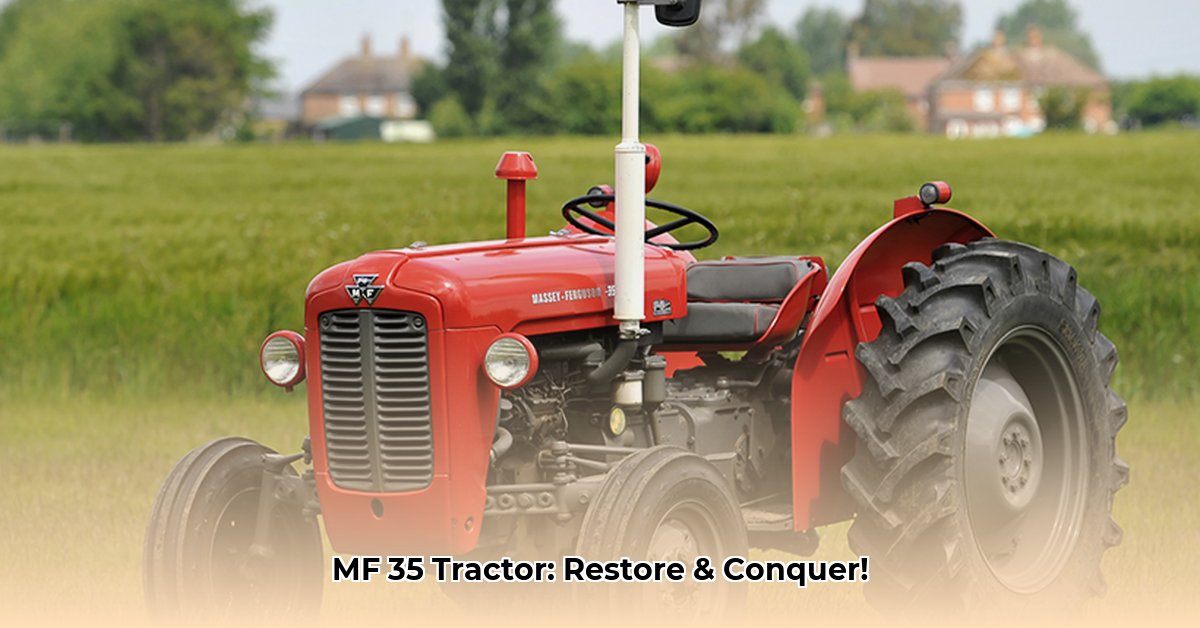
Getting to Know Your MF 35: A Piece of Agricultural History
The Massey Ferguson MF 35, produced between 1960 and 1964, isn't just an old tractor; it's a robust, reliable machine that significantly impacted farming practices. Its straightforward design and powerful 32-41 horsepower engine (horsepower varied slightly depending on the model) made it a mainstay on farms and in various industries for decades. This comprehensive guide will help you navigate the world of the MF 35, whether you are buying, restoring, or simply learning more about this iconic workhorse. Did you know its simple design contributed to its widespread adoption and enduring appeal even today? For more on higher-powered MF tractors, check out this useful resource.
Different Versions of the MF 35: Finding the Right Fit for Your Needs
Before purchasing, it's crucial to understand the variations in MF 35 models. Agricultural versions were designed for fieldwork; industrial models offered enhanced durability for tougher tasks; and turf versions provided gentler operation for lawn care. Choosing the right one depends entirely on intended use. Think of it like choosing the right tool – a hammer is ideal for nails, but not for precise woodworking.
Buying a Massey Ferguson 35: A Step-by-Step Guide to Smart Shopping
Purchasing a classic tractor differs significantly from buying a new vehicle. A methodical approach is essential.
Step 1: The Visual Inspection: Begin with a comprehensive visual assessment. Check for engine leaks, rust, transmission wear, hydraulic condition, and any other signs of mechanical wear.
Step 2: The Test Drive (If Possible): If the seller allows, conduct a thorough test drive. Listen carefully for unusual engine or component sounds, which may signify underlying issues. Assess the responsiveness of the controls.
Step 3: Authenticity Verification: Verify the tractor's authenticity. Cross-reference the serial number with Massey Ferguson records to ensure it's a genuine MF 35 and not a counterfeit.
Step 4: Price Negotiation: Thoroughly research recently sold comparable MF 35s to establish a fair market value. Negotiate confidently, leveraging your research to justify your offer.
Step 5: Documentation: Acquire all available documentation, such as service records and repair history, to gain a clearer understanding of the tractor's past maintenance and any potential issues.
Maintaining and Repairing Your MF 35: Essential Tips for Keeping it Running Smoothly
Regular maintenance is vital for prolonged, reliable operation. Consistent care prevents larger, more costly repairs down the line.
- Oil Changes: Employ the manufacturer's recommended oil type and frequency for optimal engine health.
- Fluid Checks: Regularly monitor coolant, transmission fluid, and hydraulic fluid levels and condition. Low or contaminated fluids can lead to significant problems.
- Belt Inspection: Regularly inspect belts for cracks, fraying, or wear and replace as needed.
- Tire Pressure: Maintain correct tire inflation for optimal performance and safety.
Sourcing Parts: Where to Find What You Need for Your MF 35
Locating original or replacement parts for a vintage tractor like the MF 35 can require some detective work. However, various options exist:
- Online Marketplaces: Online forums and communities dedicated to classic tractors are invaluable resources for locating parts and expert advice.
- Specialized Suppliers: Numerous suppliers focus specifically on vintage tractor parts.
- Junkyards: Local junkyards may hold hidden gems.
Restoring Your MF 35: A Rewarding Project
Restoring a vintage tractor is a significant undertaking, demanding patience, commitment, and often specialized tools. However, the end result is a deeply satisfying experience.
- Disassembly: Methodically dismantle the tractor, documenting every step with photos and detailed notes. Clean each component thoroughly.
- Repair/Replacement: Repair or replace damaged parts. This may involve engine rebuilding, transmission overhaul, or bodywork.
- Reassembly: Reassemble the tractor, using your detailed documentation. Ensure proper alignment and functionality of all components.
- Testing and Refinement: Thoroughly test all systems, making adjustments as needed. Iteration is key to success.
Connecting with online restoration communities provides access to valuable advice, support, and potential parts leads.
Operating Your MF 35 Safely: Prioritizing Safety
Safety is paramount when operating any tractor, especially a vintage one.
- Adherence to Regulations: Always adhere to local safety regulations.
- Proper Training: Ensure you are thoroughly familiar with the tractor's operation before use.
- Safe Operating Conditions: Never operate the tractor if tired, under the influence of substances, or in unsafe conditions.
Assessing the Value of Your MF 35: Determining its Market Worth
The value of an MF 35 varies greatly based on condition, completeness, and any included accessories. A pristine, well-maintained tractor commands a significantly higher price than one requiring extensive repairs. Monitoring online marketplaces and auction sites provides a current understanding of market values.
Conclusion: The Enduring Legacy of the MF 35
The MF 35 is more than just a farm machine; it represents a significant piece of agricultural history. With proper maintenance, care, and possibly restoration, this classic tractor can provide years of dependable service or a deeply rewarding restoration project. Thorough research, careful planning, and a dedicated approach are key to success.